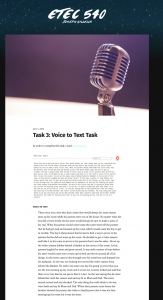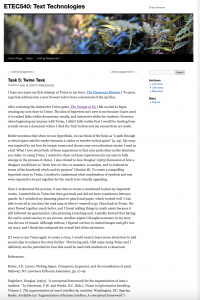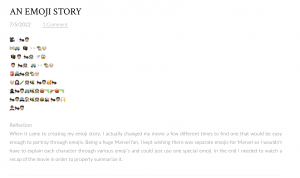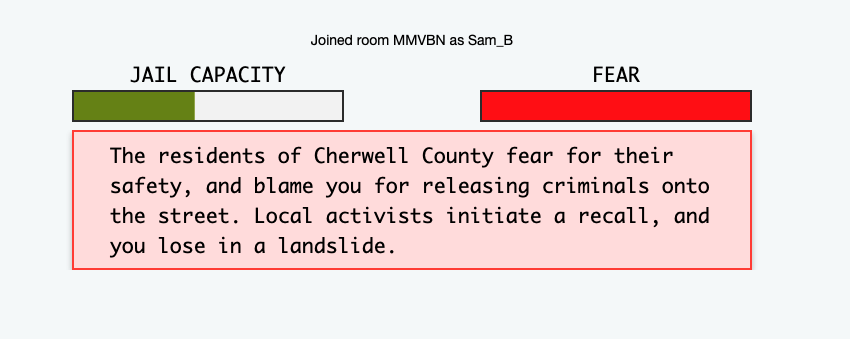
https://blogs.ubc.ca/etec540trista/2022/06/11/task-4-manual-scripts/#comment-10
by Trista Ding
Hi Trista,
Hope all is well.
I enjoyed reading your task 4, and in particular your discussion about the impact of digitalization within the workplace on our perception and usage of writing by hand. This discussion paralleled the one within the “Stuff to Blow Your Mind” podcast where they discussed the invention (and evolution of the book). When you think about it, it makes a lot of sense that as a culture that connects work with technology, we would dismiss the need or influence of hand-writing with work.
Your discussion about editing reminded me of the “Allusionist” podcast featuring Gretchen McCulloch where they discuss how auto-correct can influence the way one writes. I often turn off the grammar suggestion functionality of Word because I find it distracting.
And finally, I appreciated your assessment that writing by hand “comes from the heart.” I share that feeling, but upon reflection wonder if it is actually any different than dancing your fingers across a keyboard? Is playing an acoustic guitar any less genuine than an electric guitar? It is interesting how our minds conjure our engagement level within an activity.
- How has your colleague’s experience differed from yours? And how do you know?
Based on her description, Trista and I had similar experiences as we undertook task 4. As I explored the responses from other classmates, there was a familiar refrain within them all… technology seems to be ushering in a new non-hand-writing world that doesn’t require the same mindfulness when engaging with what is being written.
- What web authoring tool have they chosen to manifest their work?
Just like me, Trista used an image to help illustrate her hand-writing example.
- How does their tool differ from yours in the ways in which it allows content-authoring and end-user interface?
Trista used two image images that were laid out in a similar manner as the three that I displayed. I also included the writing implement in one of the images.
- What literacies does their site privilege or deny in comparison and contrast to yours?
Trista and I both used a WordPress blog site so the require literacies and functionality were nearly identical. Even the construct of our posts match as we established context then went on to discuss our observations.
- What theoretical underpinnings are evident in your/your colleague’s textual architecture and how does this affect one’s experience of the work?
The big difference between our textual architecture was that Trista focused on efficiency while I decided to focus on process of writing.
- How do the constraints of the course design manifest in your architectural choices? How have you responded to the pedagogical underpinnings of this course design in your own web space?
Not sure that either of us pushed the boundaries of the posts themselves; and not sure the tasks themselves throughout this course suggested or encouraged that approach when posting tasks. Together, in our own unique ways, we tried to uncover how writing by end influenced our approach to the materials being written. In that way the pedagogical underpinnings were uncovered through our posts.

Task 3 Voice to Text Task
By Joseph Villella
https://blogs.ubc.ca/jvillella540/2022/06/04/task-3-voice-to-text-task/#comment-2
As you point out, voice-to-text technology definitely has challenged when it comes to interpreting cadence, inflection, punctuation, and tone. There are many humans who also have challenges understanding others even when they speak the same language. Sarcasm and intonation produce meaning on their own that can’t easily be expressed through writing words. It is one of the reasons that written/visual language evolves as Gretchen McCulloch and Helen Zaltzman discuss in “Allusionist” podcast.
It takes a special kind of writer, and some creative use of punctuation, to write in a manner that duplicates how one speaks. With that said, I agree with Gnanadesikan (2011) when he says : “Spoken words, by contrast, are inherently ephemeral. So written language seems more real to us than spoken language” (p.4)
Reference
Gnanadesikan, A. E., & Wiley Online Library. (2011). The writing revolution: Cuneiform to the internet (1. Aufl.; 1 ed.). Wiley-Blackwell.
- How has your colleague’s experience differed from yours? And how do you know?
Once again in this task, many of the submissions and findings across the section were similar. Joseph’s eloquent response uncovered many of the same findings as my observations, so I would anticipate that our experiences in compiling the posts were similar.
- What web authoring tool have they chosen to manifest their work?
Both posts were uploaded to our UBC WordPress blogs. Whereas I chose to record my audio along with video, Joseph used Speechnotes and did not post his audio. He did a great job posting the processed voice-to-text and showing the differences (through striking out words) but without hearing the audio, it was hard to determine how the software came up with its interpretation.
- How does their tool differ from yours in the ways in which it allows content-authoring and end-user interface?
As described above the layouts of our content shared some similarities but mine was slightly more dynamic in the materials offered for review.
- What literacies does their site privilege or deny in comparison and contrast to yours?
The omission of the audio file within Joseph’s post inhibited the user from fully understanding the context.
- What theoretical underpinnings are evident in your/your colleague’s textual architecture and how does this affect one’s experience of the work?
Constructivism is the basis of most of the presented tasks. As such, context was essential to fully interpreting and building upon the content presented. As stated above, the lack of context gave the sense of a missing step in the process within Joseph’s post.
- How do the constraints of the course design manifest in your architectural choices? How have you responded to the pedagogical underpinnings of this course design in your own web space?
Both Joseph and I describe our findings through responding to the prompts laid out in the assignment outline. We both referenced texts from the week’s module to emphasize the correlation between the task and the module’s content.

Task 1 What’s in your bag?
By Jennifer Guth
https://blogs.ubc.ca/jgttetec540/2022/05/28/task-1-whats-in-your-bag/#comment-3
Thanks for sharing your task 1. It is a fascinating peek into your digital footprint, and I enjoyed how you integrated the key themes of the course into your post. Your apps seem to fall into three categories: entertainment, information, and communication. All three categories are woven together so seamlessly.
While I am a fan of podcasts and reading, I just haven’t embraced audiobooks. I quite enjoy my e-reader, and don’t require the tactile nature of books, but for whatever reason I have yet to jump into eBooks. Out of interest, I just checked, and discovered that Adobe Reader provides a read out loud function that reads PDF text. Might try to convert some epubs and pdfs to test out this function although not sure it will be as good as a professional unautomated book reader.
When I think about my own connection to technology and text/information, I often fear the same things as Postman describes in Technopoly. “New technologies alter the structure of our interests: the things we think about. They alter the character of our symbols: the things we think with. And they alter the nature of community: the area in which thoughts develop” (Postman, 1993, p.20).
Just the other day, I was reflecting on the types of mobile phone I have had over the past twenty years from thick “un-app-ed” bricks to fancy touch devices that are far more powerful than the first computer I ever used. As the functionality of mobile devices evolve, so does our reliance on them as tools to communicate and interact.
References
Postman, N. (1993). Technopoly: The surrender of culture to technology (1st Vintage Books ed.). Vintage Books.
- How has your colleague’s experience differed from yours? And how do you know?
Jennifer elected to explore her mobile device, or digital bag as she called it, instead of a physical bag and as a result our experiences differed. Although I explore tangible content of my bad, Jennifer delved into an exploration of what applications she used, why, and how she interacted with them
- What web authoring tool have they chosen to manifest their work?
We both used UBC’s WordPress blog for posting our tasks
- How does their tool differ from yours in the ways in which it allows content-authoring and end-user interface?
Jennifer sub-divided her content into key themes whereas I struck to the questions as defined in the last.
- What literacies does their site privilege or deny in comparison and contrast to yours?
As our audiences were the same, not sure the required literacies differed much in this task. If it had been a general audience perhaps some users may have had a challenge understanding the app concepts, but then again they may have had a challenge understanding some of the photography and videography terms I used as well.
- What theoretical underpinnings are evident in your/your colleague’s textual architecture and how does this affect one’s experience of the work?
All of the ETEC 540 tasks included some form of constructivism, and required users to make connections between the task content and that of the module. As such, the experience would have been similar for the majority of readers (who had also reviewed the week’s module).
- How do the constraints of the course design manifest in your architectural choices? How have you responded to the pedagogical underpinnings of this course design in your own web space?
As described above, I really tried to incorporate several levels of texts within all my texts and this was no exception. From multiple images to responses that followed the content of each aligned module. While Jennifer’s submission was great, the lack of additional media reduced its impact since it lacked some context. As this was the first task, the majority of the class attempted to build upon the example provided (that in itself is a constraint).

Task 5 Twine Task
By Trista Svennes
https://blogs.ubc.ca/metetec540/2022/06/16/task-5-twine-task/#comment-5
Hi Trista,
I wasn’t able to open your Twine, but I did enjoy reading about your approach to this task. We shared a number of similarities in our approaches. Your response made me reflect on how the medium (in this case Twine) influences our creative process by limiting the flow of ideas similar to how Douglas (1963) described the design process. While some writers and designers can think on multiple levels simultaneously, I get the sense that most of us are more linear in our approach and need to parse it into sections based on context.
- How has your colleague’s experience differed from yours? And how do you know?
I shared Trista’s enthusiasm for this task. The opportunity to explore Twine and see what we could create was an exciting premise.
- What web authoring tool have they chosen to manifest their work?
I had no success in downloading and playing Trista’s Twine (much like others with my submission), so I’m not sure the authoring tool was ideal.
It would have been beneficial to find a Twine player to house and play the stories, and embed that player into our blogs. However, I haven’t had any success in finding one.
- How does their tool differ from yours in the ways in which it allows content-authoring and end-user interface?
We used the same tool, and a similar approach to build our stories, so I don’t think the experience differed much. I tried to incorporate music and animations (the latter with little success), so that would have been one of the differences.
- What literacies does their site privilege or deny in comparison and contrast to yours?
Twine was a fun platform to explore, but because of its programming, it was not very intuitive. As a result, one’s technical literacy is paramount to success.
- What theoretical underpinnings are evident in your/your colleague’s textual architecture and how does this affect one’s experience of the work?
I appreciated how Trista made natural connections to Bolter’s hyperlink discussion. That sense of connectivity between concepts and content within Twine really helped bring these linkages to life.
- How do the constraints of the course design manifest in your architectural choices?
The biggest constraint with regards to this task was Twine itself. I’m sure one can take multiple training courses in how to use Twine (especially in order to develop content like the provided example), so it almost seemed unfair to show the example and only provide a week to develop our own content.
- How have you responded to the pedagogical underpinnings of this course design in your own web space?
Our webspaces are relatively easy to navigate. Trista created a few menus while I elected to use only one assignment menu.

Task 8: Golden Record Curation Assignment (Mandatory task)
By Zoe Armstrong
Hi Zoe,
Thank you for your thoughtful overview of the Politics of Text. Having approached the task in a similar manner, I really appreciated how you elucidated your rationale. In particular, your reflection piece when it came to how sound can influence the listener.
BTW I am going to check out Serato – sounds cool!
I was also struck on how you visually represented to scope of the works globally. That map was a great example of the connecting the musical choices with their locales.
Thanks for sharing!
- How has your colleague’s experience differed from yours? And how do you know?
Zoe did a great job of uncovering Serato to help guide her musical choices. My choices were a reflection of striving to provide a broad collection of music based on genre, era, and location. As it turned out our final decisions were similar.
- What web authoring tool have they chosen to manifest their work?
I am looking forward to investigating how Serato works, and finding some usages for it. Upon reflection, I should have track down some album covers or other materials to showcase the music and my choices.
- How does their tool differ from yours in the ways in which it allows content-authoring and end-user interface?
I think our layouts with the blog format were very similar, and as a result the user experience would most likely be the same as well.
- What literacies does their site privilege or deny in comparison and contrast to yours?
Using Serato enabled Zoe to appeal to more musicology-piles rather than my approach that was not as technical.
- What theoretical underpinnings are evident in your/your colleague’s textual architecture and how does this affect one’s experience of the work?
We were exploring digitizing in this module, and it was fun to reflect on my experience in radio and television while doing this task. Much of my work from that time is now on formats that are challenging to digitize without particular analogue to digital equipment.
- How do the constraints of the course design manifest in your architectural choices?
I do wonder about the accessibility of this task for those that have a hearing impairment. I wasn’t able to find many visual representations of the musical selections.
- How have you responded to the pedagogical underpinnings of this course design in your own web space?
I used a table to display my selections while Zoe bolded the titles and provided her explanation in paragraph form.

Task 9 Visualizations of the Golden Record Selections
(Website commentary is not enabled)
By Al Carmichael
Hi Al,
Thank you for sharing your analysis of the Golden Record Curation selections. Your efforts to better visualize and analyze the data helped me get a better sense of the information as it was initially presented in manner that was hard to extrapolate any findings. While I was able to play around with the application, I found it challenging especially on a Mac (you’d think it should be more intuitive on a Mac?!). While our conclusions were similar, I agree that “correlations (of the responses) can merely suggest hypotheses, which must then be tested, and we are lacking further data upon which to test.”
I left this task wanting to find out more about the rationales. It was something that the visualization just couldn’t provide. If that additional information was available the previous task would have required a much more robust submission.
BTW love the t-shirt idea!
- How has your colleague’s experience differed from yours? And how do you know?
Allan really explored the software and was able to delve into the analytics much more effectively than me. I wondered if the issue was that I was using a Mac and not a PC. When I tried to manoeuvre my way through the platform I kept encountering obstacles.
- What web authoring tool have they chosen to manifest their work?
Allan’s layout within his blog was great, but didn’t allow for comments on the platform. Instead I sent him a message through Canvas to provide my comments.
- How does their tool differ from yours in the ways in which it allows content-authoring and end-user interface?
As discussed above, the inability to comment on the post was the only issue I encountered when interacting with Allan’s post.
- What literacies does their site privilege or deny in comparison and contrast to yours?
I endeavoured to expand on the concepts and literacies we were investigating in this module whereas Allan really focused on the data that was being discussed. I think both approaches are effective in their own respective ways.
- What theoretical underpinnings are evident in your/your colleague’s textual architecture and how does this affect one’s experience of the work?
Hopefully my response encouraged others to reflect on their choices and those of our colleagues. The module topic for Week 9 was a network of texts, and together thinking about the data and the interplay between the musical choices was evident between our two submissions.
- How do the constraints of the course design manifest in your architectural choices? How have you responded to the pedagogical underpinnings of this course design in your own web space?
How we interact with different technologies and what texts mean to us have been big take-aways for me within ETEC 540. Finding linkages between tasks from colleagues tended to be easy as we all endeavoured to integrate the pedagogical underpinnings of the course and its design into our weekly responses. Task 9 was no exception.

[6.4] Task 6: An emoji story (Optional task)
By Kayli McKay
https://mskmckay.weebly.com/etec-540/an-emoji-story#comments
Hi Kayli,
I tried to stick to my original movie choice but it was tough in the Emoji task. Thought you told an amazingly accurate story using emojis… And who knew their was an ant emoji. I decided to take a much high-level explanation of the movie otherwise the emoji “story” would have been so many lines longer.
What were your thoughts about this task? I appreciated that it provided an opportunity to translate something using a universal language. Although that universal language could still be interpreted in different ways.
- How has your colleague’s experience differed from yours? And how do you know?
Kayli’s response provide insight into how she approached the emoji task, and our approaches were very similar.
- What web authoring tool have they chosen to manifest their work?
Having seen Ant Man, it was fun to de-code her description of the film. It was similar to playing Pictionary.
- How does their tool differ from yours in the ways in which it allows content-authoring and end-user interface?
It would have been fun to gamify these submissions so that users could provide their interpretations of the emoji sentences
- What literacies does their site privilege or deny in comparison and contrast to yours?
There were no particular literacies required in this task however if the user did not pay attention to pop culture, they may have difficulty determining what movies or shows are being depicted. With that said, emojis felt universal in that it is a visual language.
- What theoretical underpinnings are evident in your/your colleague’s textual architecture and how does this affect one’s experience of the work?
That visual language was what really impacted during this task, and through the week’s readings.
- How do the constraints of the course design manifest in your architectural choices? How have you responded to the pedagogical underpinnings of this course design in your own web space?
Other than the potato art task, this one seemed the most accessible to me. Mind you, if a student was visually impaired this task would have been much more challenging. I wonder if there is value in creating a descriptive video task as an alternative.


